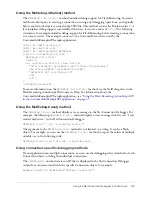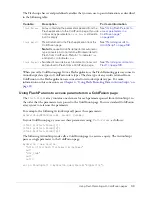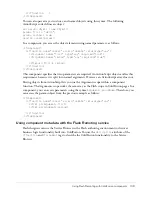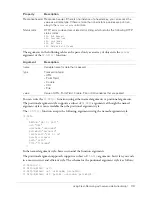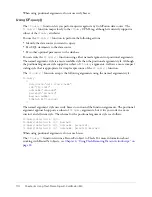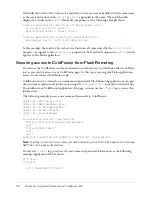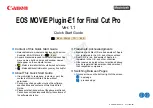
102
Chapter 6: Using Flash Remoting with ColdFusion MX
You access
x
and
y
in your ColdFusion page using ColdFusion array and structure notation,
as follows:
<cfset arrayElement1=Flash.x[1]>
<cfset arrayElement2=Flash.x[2]>
<cfset structElement1=Flash.y.zero>
<cfset structElement2=Flash.y.one>
You can pass ActionScript objects to ColdFusion pages. The following ActionScript defines
an object:
var myObj:Object = new Object();
myObj.x = "one";
myService.myMethod(myObj);
In ColdFusion, you access the object elements using named parameters in the Flash scope,
as follows:
<cfset p1=Flash.x>
Returning results to ActionScript
In ColdFusion pages, only the value of the
Flash.Result
variable is returned to the Flash
application. Although you are limited to returning a single variable to the Flash application, that
variable can contain a single value, an array, a structure, or a record set returned from a
ColdFusion query.
For more information about converting data types between ColdFusion and Flash, see
Chapter 4,
“Using Flash Remoting Data in ActionScript,” on page 63
.
The following procedure creates the service function helloWorld, which returns a structure that
contains simple messages to the Flash application.
To create a ColdFusion page that returns a structure:
1.
Create a folder in a directory accessible to ColdFusion and your web server, and name it
helloExamples. This directory can go under your web root directory.
2.
Create a ColdFusion page, and save it as helloWorld.cfm in the helloExamples directory.
3.
Edit the helloWorld.cfm page to insert the following code:
<cfset tempStruct = StructNew()>
<cfset tempStruct.timeVar = DateFormat(Now ())>
<cfset tempStruct.helloMessage = "Hello World">
<cfset Flash.Result = tempStruct>
In the example, you add two string variables to a structure, one with a formatted date and one
with a simple message. The structure is returned to the Flash application using the
Flash.Result
variable.
4.
Save the file.








